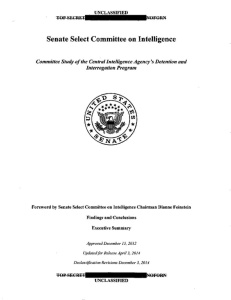
Following the September 11, 2001, terrorist attacks and the pronouncement of the War on Terror, the U.S. government began capturing and detaining members of al-Qaeda and other terrorist groups. Under the U.S. Constitution, the Geneva Conventions, and long-standing international law, these detentions were perfectly legitimate. I addressed the question of the legality of these detentions and of military tribunals in The War in Iraq: Ten Myths (see Myth #1). But while the detentions and tribunals were legal in-and-of themselves, torturing those prisoners was not.
While prisoners at Guantanamo Bay, Cuba, and elsewhere are not protected under the Third Geneva Convention because they do not meet the definition of ‘prisoner of war,’ they are most certainly protected under the Convention Against Torture and Other Cruel, Inhuman, or Degrading Treatment and Punishment. This treaty, commonly known as the United Nations (U.N.) Convention Against Torture, was adopted by the U.N. General Assembly in 1984. It came into force in 1987 after having been ratified by twenty-six nations. Today, 156 nations are party to the treaty.
President Ronald Reagan (R) signed the Convention Against Torture in 1988, and it was ratified by the U.S. Senate in 1994. Since then, it has been the ‘law of the land’ under Article VI of the U.S. Constitution: “This Constitution, and the Laws of the United States which shall be made in Pursuance thereof; and all Treaties made, or which shall be made, under the Authority of the United States, shall be the supreme Law of the Land; and the Judges in every State shall be bound thereby, any Thing in the Constitution or Laws of any State to the Contrary notwithstanding” (emphasis added).
So what does the Convention Against Torture entail? Well, you can dig through the full text if you want, but I would like to highlight two important clauses. First, here the legal definition of torture under the treaty:
For the purposes of this Convention, the term “torture” means any act by which severe pain or suffering, whether physical or mental, is intentionally inflicted on a person for such purposes as obtaining from him or a third person information or a confession, punishing him for an act he or a third person has committed or is suspected of having committed, or intimidating or coercing him or a third person, or for any reason based on discrimination of any kind, when such pain or suffering is inflicted by or at the instigation of or with the consent or acquiescence of a public official or other person acting in an official capacity. It does not include pain or suffering arising only from, inherent in[,] or incidental to lawful sanctions.
Part I, Article 1.1
And second, here is what the treaty has to say about making exceptions to the rule, and the ‘just following orders’ defense:
No exceptional circumstances whatsoever, whether a state of war or a threat of war, internal political instability[,] or any other public emergency, may be invoked as a justification of torture. An order from a superior officer or a public authority may not be invoked as a justification of torture.
Part I, Article 2.2-2.3
Pretty clear if you ask me. . . .
We already knew that the CIA (and possibly other government agencies) subjected prisoners in the War on Terror to ‘waterboarding‘ and other ‘enhanced interrogation techniques’ to elicit confessions or other information from prisoners. Waterboarding is a method of simulating drowning, and can lead to extreme pain and panic, as well as damage to the lungs and possibly even brain damage from oxygen deprivation.

Members of President George W. Bush’s (R) administration issued legal opinions stating that waterboarding was not torture, but it is hard to see how it does not meet the definition laid-out in Part I, Article 1.1, of the Convention Against Torture. Senator John McCain (R-AZ) points out that, long before the Convention Against Torture, the U.S. government considered waterboarding to be a form of torture. We tried Japanese captors who waterboarded U.S. prisoners during World War II for war crimes and then hanged them. McCain also points out that waterboarding was invented and first used during the Spanish Inquisition, and it was regularly used by General Secretary Pol Pot and his Khmer Rouge organization during the Cambodian genocide. Considering that McCain was a prisoner of war during the Vietnam War, and was himself subjected to torture, maybe his opinion has some serious weight here.
I have long supported a strong anti-terror policy, but I have never supported torture . . . and when it became clear that the Bush administration was subjecting prisoners to waterboarding, and after I learned what waterboarding actually is and how it has been viewed historically, I condemned its use unequivocally. I also condemned politicians like Representative Nancy Pelosi (D-CA 12th) who were briefed about these ‘enhanced interrogation techniques’ by the CIA back in 2002, raised no objections at the time, but then condemned the torture later when the public found out about it. Politicians like Bush and former Vice President Dick Cheney (R), who approved and still support this kind of torture, are pretty bad . . . but at least they have been consistent, and have tried to make rational arguments for their positions. I don’t know what’s scarier, a politician like Cheney who openly and publicly supports torture, or a politician like Pelosi who only supports torture when she thinks nobody will ever find out about it.
On December 9, 2014, the United States Senate Select Committee on Intelligence (SSCI) publicly released part of a report on the Central Intelligence Agency’s (CIA) detention and interrogation programs—the Committee Study of the Central Intelligence Agency’s Detention and Interrogation Program. The report, generally known as the CIA Torture Report, is six-thousand pages long and took five years to create. Much of it remains classified, but a 525-page portion was released to the public, including the key findings and the executive summary (with some portions redacted) . . . and it is damning. The report shows that the CIA abused and systematically mistreated its prisoners and subjected them to numerous types of torture (including the waterboarding that we already knew about), and then lied about it to the government authorities charged with oversight of CIA operations.
There were more detainees, they were treated more harshly, and there were more torture techniques used than had been previously disclosed. The CIA destroyed more than one hundred video recordings of torture sessions in an effort to cover up its illegal activities. The CIA illegally withheld information about the program from the Department of Justice, the White House, the U.S. Congress, and their own CIA Office of Inspector General. The report also claims that, despite all of this, the CIA gained only minimal useful intelligence from its interrogation programs, and the information that it did gain could have been gained in other ways.
What kinds of torture techniques are listed in the report? Here are some examples:
- Some prisoners were subjected to anal force-feeding.
- Prisoners were given ‘forceful’ rectal exams for no apparent reason, and at least one prisoner was later diagnosed with hemorrhoids, anal fissure, and rectal prolapse . . . symptoms usually associated with violent anal rape.
- One prisoner died from hypothermia.
- At least four prisoners were given serious leg injuries (breaks and sprains) and then forced to stand on them.
- One interrogator played Russian Roulette with a prisoner (it is unclear if the gun was actually loaded).
- At least two prisoners were subjected to mock executions.
- Several prisoners became unresponsive and/or nearly drowned during waterboarding sessions.
- One prisoner’s eye was so badly damaged during his detention that it had to be removed.
- Prisoners were kept awake for over a week (which can cause serious physical and psychological harm).
- One prisoner was locked in a coffin-sized box for more than eleven days.
- One prisoner was locked in a 2.5 x 2.5 x 1.75 foot (76 x 76 x 52 cm) box for twenty-nine hours.
- One prisoner was made to stand with his hand over his head for two and a half days, at times with a pistol to his head.
- One prisoner was tortured for numerous months based solely on an informant’s testimony (which turned out to be false).
- One prisoner was subjected to ice-water baths, and made to stand awake for sixty-six hours . . . and he turned out to have been falsely imprisoned based on a mistaken identity.
Not only were prisoners tortured far beyond the narrow legal limits under law and treaty, but more than twenty percent of the prisoners held by the CIA were subsequently determined to have been detained improperly. President Bush’s authorization for CIA detention only permitted people who posed a “continuing, serious threat of violence or death to U.S. persons and interests” to be detained . . . and yet at least two detainees were completely innocent, two U.S. informants were ‘accidentally’ captured and detained, and one mentally challenged man was detained only in an effort to persuade his family to provide information to the CIA.

Many politicians have expressed criticisms of the report. Cheney called the report “a bunch of hooey,” and said that harsh interrogation techniques were “absolutely, totally justified.” He even said that, “If I had to do it over again, I would.” Current CIA Director John Brennan, while he opposes the use of ‘enhanced interrogation techniques’ and supports President Barack Obama’s (D) anti-torture policies, disagreed with the report’s conclusions that other interrogation techniques could have yielded the same information. Three former CIA Directors who served under Bush—George Tenet, Porter Goss, and Michael Hayden—published an opinion piece in the Wall Street Journal that labeled the report a ‘partisan attack’ and said that the interrogation program yielded invaluable intelligence that disrupted al-Qaeda and helped bring Osama bin Laden to justice. A number of Republican Senators—including Saxby Chambliss (R-GA), Mitch McConnell (R-KY), Jim Risch (R-ID), and Marco Rubio (R-FL)—also characterized the report as a partisan effort by Democrats that would harm U.S. national security.
Let us presume, for the sake of argument, that these critics are correct. Let’s imagine that the CIA Torture Report badly over-states what happened at Guantanamo and elsewhere, that the ‘enhanced interrogation techniques’ were basically just waterboarding, and that they actually yielded useful and reliable intelligence about our enemies that could not have been had any other way. And let’s accept that the report is, indeed, going to harm our image abroad and U.S. national security interests (which is probably true).
Even so, we know that the CIA used waterboarding torture on its prisoners. This is undisputed, even among the most conservative of Republicans. And we know that we are bound by the Convention Against Torture, a duly signed and ratified treaty that the U.S. Constitution gives equal standing with itself as the law of the land under Article VI. And we know that, whether we think waterboarding ought to count as torture, the definition of torture under Part I, Article 1.1, of the Convention Against Torture is broad enough to include it, and Part I, Article 2.2-2.3, of the same treaty grants absolutely no exceptions for national emergencies or war.

The Republican Party is supposed to be the ‘rule of law’ party, so the loud voices on the Republican side of the aisle condemning this report and defending the use of torture as having been ‘useful’ ought to silence themselves and engage in some honest introspection. Whether the torture yielded useful intelligence is irrelevant, because it was illegal and immoral. Whether it saved lives when considered in a utilitarian ‘number saved vs. killed’ sense is irrelevant, because moral [and legal] ends do not justify immoral [and illegal] means. And whether publicizing the report harms our image abroad or undermines our national security interests is irrelevant, because the American people are our sovereigns, and we have a right to know what has been done in our name.
Those complaining about this report—most especially those who signed-off on or participated in these programs in the first place—are like a murderer who only gets upset because he gets caught. A healthy, moral person shows some remorse about the crime itself, maybe turns himself in to help silence his nagging conscience, and maybe pleads guilty when caught and begs for forgiveness. A sociopath, on the other hand, shows no sign of remorse . . . perhaps saying something like, “If I had to do it over again, I would.”
I’m not upset because part of this report has been released . . . no, I’m upset because the CIA, with varying degrees of complicity from other federal agencies, the U.S. Congress, and the Bush administration, tortured people. I’m upset because a bunch of ‘rule of law’ Republicans, opportunist Democrats, and other government officials sworn to protect and defend the U.S. Constitution had no apparent concerns with violating it when it became an inconvenient impediment. I’m upset because far too many many people—from the lowest-ranked CIA agents to the highest-ranked administration officials—still haven’t learned that ‘just following orders’ isn’t a valid defense, and the ends do not justify the means.
The War on Terror continues whether we like it or not, and we should fight it with unwavering resolve and clear-headedness . . . but we cannot lose our moral compass along the way. The U.S. Constitution is the law of the land, and its provisions are non-negotiable (unless amended). Treaties like the Convention Against Torture must be obeyed. And the Bill of Rights must not be treated as an inconvenient impediment to be ignored in the name of expediency.
Could we find and neutralize more terrorists if we continued to engage in illegal torture, widespread domestic surveillance, and other extra-constitutional activities? Possibly. But if we are willing to throw out our most sacred laws and moral sense in the name of defending America, then there is nothing left worth defending anyway.

